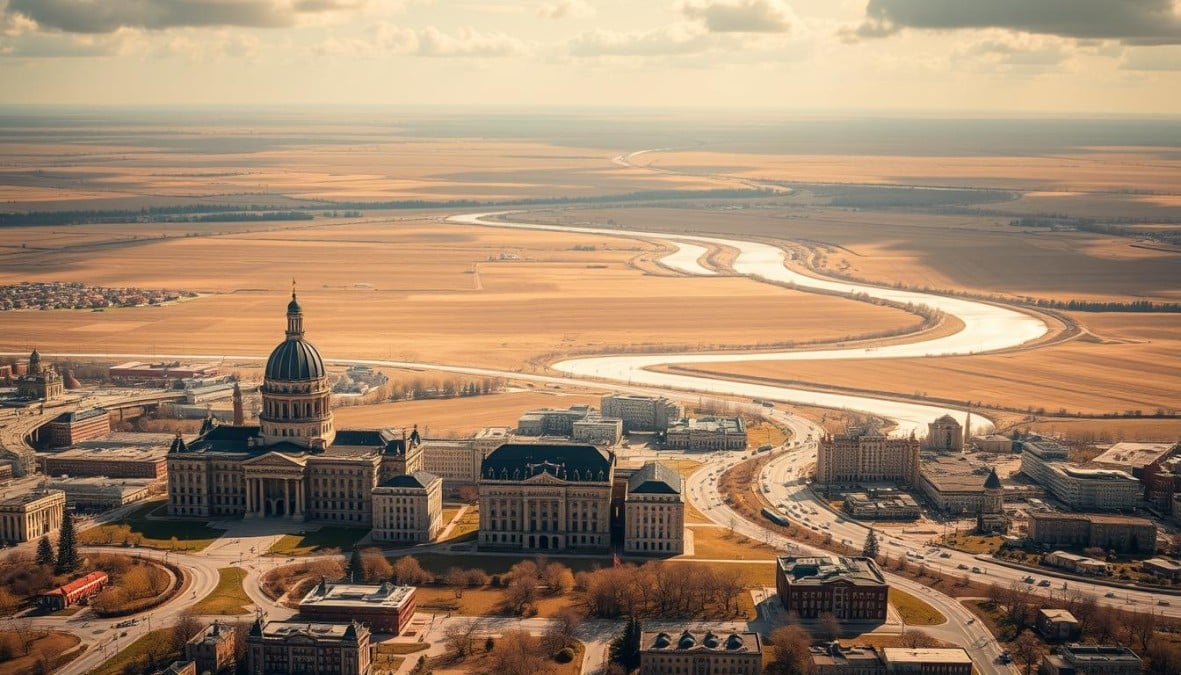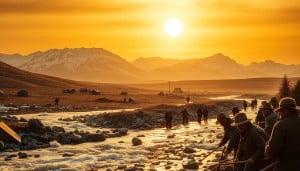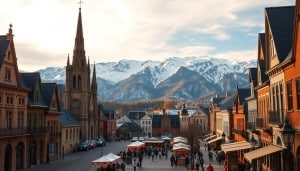Manitoba sits at our nation’s heart, rich in history that spans thousands of years. This province is the true center of Canada, both in location and spirit. It joined Canada on July 15, 1870, as the fifth province. This event marked the start of Manitoba’s crucial role in the country’s growth.
Exploring Manitoba’s history takes you back to times before Winnipeg was its heart. The province’s history is alive with the motto “Gloriosus et Liber,” showing its people’s strength and freedom. This spirit is woven into Manitoba’s colorful past. Its governance foundation established resilience, shaping a strong province within Canada.
Now, with over 1.3 million people, Manitoba shines as a bilingual beacon. It offers a warm welcome in both English and French. Join us to uncover the rich legacy of Manitoba. Let’s celebrate the pioneers who made it a symbol of growth and freedom.
Introduction to Manitoba’s Rich Heritage
We’re excited to show you the beautiful Manitoba’s cultural heritage . It’s deeply rooted in Indigenous history . For thousands of years, Manitoba’s story has unfolded, with events like the Red River Rebellion shaping it. This event changed our governance and showed our drive for justice and freedom.
Manitoba’s identity comes from its Indigenous and Métis people. Their tales, challenges, and achievements are our heritage’s core. Winnipeg, at Manitoba’s heart, is a witness to history, filled with landmarks and stories. They invite you to feel our province’s enduring spirit.
These stories of grit and unity are precious to us. They resonate in our arts, communities, and daily lives. Every piece, from historic sites to festivals, shows the lasting impact of those who left their mark here.
| Event | Impact on Manitoba |
|---|---|
| Indigenous Settlements | Fundamental development of regional culture and community structures |
| Red River Rebellion | Pivotal in shaping modern governance and bolstering Métis rights |
| Cultural Integration | Blending of Indigenous, Métis, and European cultures creating a unique cultural heritage |
We invite you, whether living here or just visiting, to explore Manitoba’s unique stories and landmarks. Let’s appreciate and learn from the rich cultural history that makes Manitoba a special place in Canada’s heart.
Indigenous Peoples and Early Inhabitants
Before Europeans came, Indigenous peoples shaped Manitoba. They played a big role in Manitoba’s role in Canadian history . The Anishinaabe and Cree, among others, lived here first. They created a culture that’s still part of Manitoba today.
The Anishinaabe and Cree Nations
The Anishinaabe and Cree were vital in creating Indigenous history of Manitoba . They share stories that show their deep connection to the land. Their ways of living with nature were based on respect and sustainability.
Cultural Practices and Traditions
Indigenous festivals, storytelling, and dances add to Manitoba’s culture. They offer a glimpse into history and shape today’s culture too.
Contributions to Manitoba’s Identity
Manitoba pioneers include Indigenous peoples too. They made paths and trade networks, like at The Forks in Winnipeg. This spot shows the lasting impact of First Nations and Métis peoples. They helped make Manitoba what it is now.
The stories of these Indigenous nations are a big part of Manitoba. They help it grow and keep its unique identity.
European Exploration and Settlement
Exploring Manitoba’s history, we see the big impact of European exploration. It started with explorers looking for new lands. This time was key because of the teamwork and fights that changed the area a lot. We’ll look at important parts of this era, like the first explorers, big trading companies, and how Indigenous communities were affected.
Early Explorers in the Region
In Manitoba, stories often start with European explorers. These explorers came for the vast resources and opportunities. Their discovery and meetings with Indigenous peoples laid the basis for Winnipeg’s history.
The Establishment of the Hudson’s Bay Company
In 1670, King Charles II helped start the Hudson’s Bay Company. It was a big deal in business and for controlling the fur trade in Rupert’s Land. The company had a big effect on Manitoba’s social and economy.
Impact on Indigenous Communities
New trade routes and forts brought chances but also big changes for Indigenous communities. The relationship between settlers and Indigenous peoples was layered, with trade and sadly, conflicts. These changes deeply affected the lives of local Indigenous peoples, changing their culture and land.
Today, as a nation, we look back at these historical events. We recognize the many stories that make Manitoba’s history—a story of overcoming, working together, and deep change.
Manitoba’s Formation as a Province
Manitoba joined the Canadian Confederation on July 15, 1870. It was an important moment in Manitoba’s history. The Red River Rebellion played a big role in this, showing the Métis people’s unique cultural and political goals.
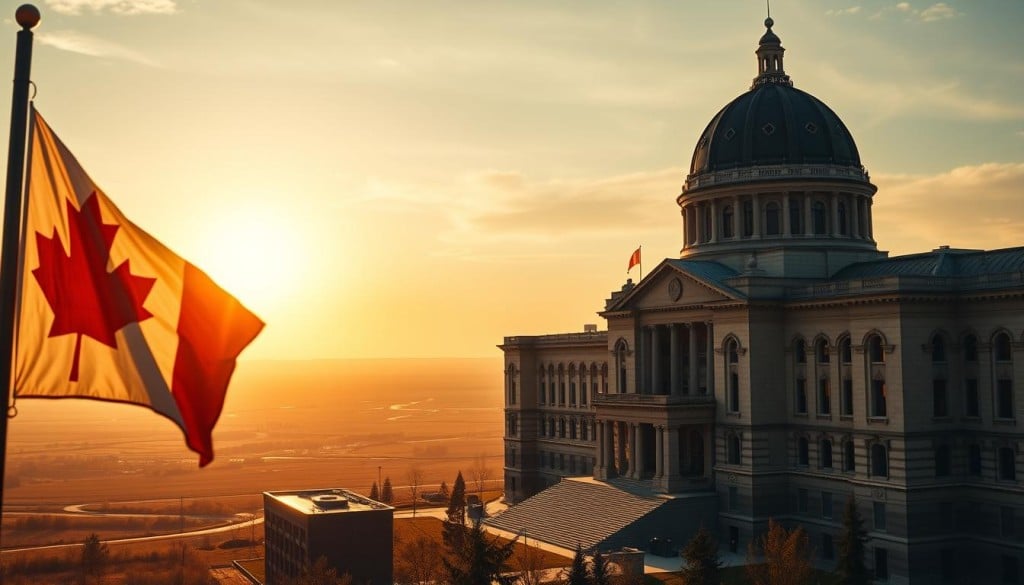
The Legislative Assembly of Assiniboia helped shape early Manitoba. It was key for democracy and making policies during hard times. But, getting Rupert’s Land from the Hudson’s Bay Company was tough. It involved tricky talks and led to uncertainty and resistance locally.
Louis Riel was a major figure at this time, fighting for Métis rights. He has a lasting impact on Manitoba’s politics.
Now, let’s look more at how these events helped form Manitoba:
Confederation and Its Implications
Manitoba’s entry into Confederation was a careful political move. It secured land and cultural rights through the Manitoba Act. This was a big deal for Canada’s growth and started talks on provincial and federal rights.
Early Governance and Policies
Manitoba’s first years focused on policies for welcoming different cultures and setting up government. These early actions helped build the legal and social base needed for growth.
Challenges in the Emerging Province
The young province faced many challenges. These included land disputes from the Red River Rebellion and the complexities of setting up a government. It was essential to have strong leadership and open talks to overcome these problems.
The Role of Agriculture in Manitoba’s Growth
Agriculture has shaped the agricultural history of Manitoba and boosted its economy. From the Red River Valley’s fertile lands to the vast prairies, farming in Manitoba has seen big changes. These changes have driven growth in the province.
Agricultural Innovations and Advances
Manitoba has always been a leader in farming innovation. With new tech and sustainable methods, Manitoba stays ahead globally. This keeps the province as Canada’s breadbasket.
The Homesteading Era
The homesteading era was key in the agricultural history of Manitoba . It attracted settlers with free land offers. They boosted farming and made Manitoba’s crops more diverse. This helped the province’s economy grow a lot.
Economic Impact on the Community
Agriculture has a big impact on Manitoba’s communities. It creates farming jobs and helps other sectors like manufacturing and technology. These industries help make Manitoba’s economic development history even richer.
Supporting agriculture in Manitoba means building a better economy for everyone. By remembering our farming and innovation history, we can make this sector even stronger.
Industrial Development in Manitoba
Manitoba’s economy has a unique story, with industry playing a key role. Manufacturing helped the province grow, especially in cities like Winnipeg.
The 20th century brought important industries to the forefront in Manitoba. Metallurgy, machinery, and food processing became the main drivers of growth. These fields not only diversified the economy but also created jobs.
Winnipeg’s growth was closely linked to these industrial activities. This led to better transportation, housing, and public services. These were vital for a larger workforce.
Agriculture and industry depended on each other in Manitoba. This bond fueled the economy and pushed for new inventions and technology.
Manitoba’s journey of industrialization highlights its ongoing importance. It shows how industries can uplift local economies and improve living standards.
The Diversity of Manitoba’s Population
Manitoba’s people come from many backgrounds, each adding something special. This mix isn’t just history. It’s a big part of what Manitoba is today.
Throughout history to today, Manitoba has welcomed people from all over. Its culture is rich thanks to many influences. Together, they add to the province’s life and growth.
- Immigration Waves and Contributions: Many have made Manitoba their home, from Ukrainians to Filipinos to Indians. They’ve brought their unique cultures, languages, and traditions, making Manitoba’s social scene richer.
- Celebrating Cultural Diversity: Manitoba loves to celebrate its mix of cultures. It hosts festivals like Folklorama and the Winnipeg Folk Festival, showing off its cultural wealth.
- Modern-Day Demographics: Today, Manitoba, especially Winnipeg, is more mixed than ever. This diversity is a source of pride, bringing people together in celebration.
This multicultural vibe in Manitoba weaves a unique tapestry. It shapes the province’s culture, making it a welcoming place. Knowing about Manitoba’s diverse people helps us understand its past, present, and future.
Manitoba in War and Peace
Throughout its storied past, Manitoba has significantly shaped Canadian resilience and national identity. It played a crucial role, both in war and peace. Reflecting on Winnipeg’s military history and Manitoba’s political past fills us with pride.
Impact of World War I and II
The wars brought big changes to Manitoba. Many local men and women joined the Canadian Armed Forces. The province was key to the war efforts, hosting training and operations vital to the Allies.
Communities in Manitoba supported these efforts in many ways. They held war bond drives and sent care packages to troops overseas.
Contributions to the Canadian Armed Forces
Manitoba’s role went beyond the battlefields. Winnipeg was at the heart of military efforts, with several training bases. Under the British Commonwealth Air Training Plan, thousands of pilots were trained here. This highlights Winnipeg’s crucial military role during the wars.
Post-War Recovery and Development
After the wars, Manitoba saw big social changes and economic growth. The focus was on rebuilding and modernizing the economy. This period reshaped Manitoba’s political history, aiming to improve life quality in peacetime.
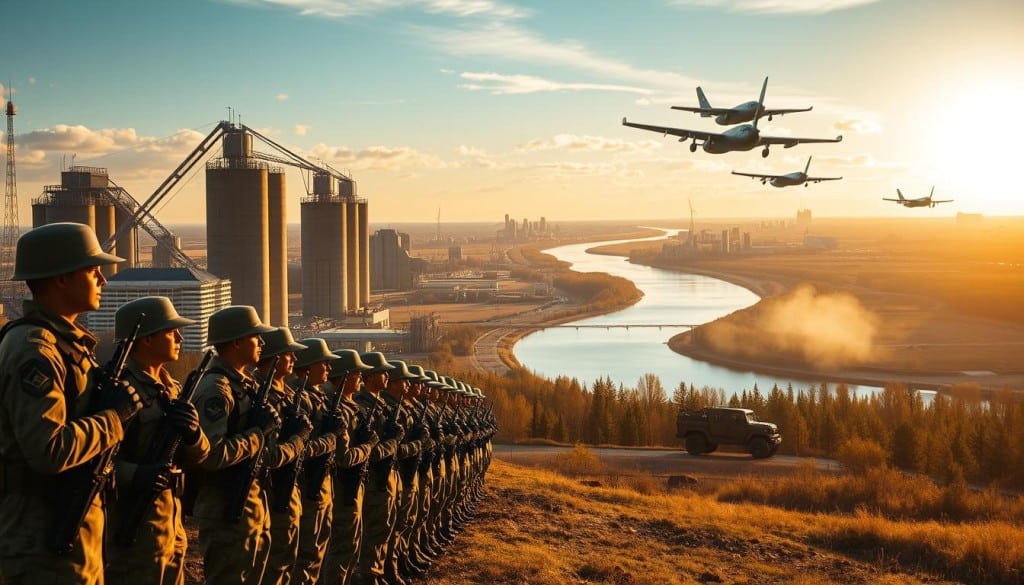
We treasure the history that shows Manitoba’s resilience and community spirit. These stories not only shape our culture but also push us towards peace and prosperity. We honor those from Manitoba who served, ensuring their legacy inspires our future.
Manitoba’s Cultural Institutions
Manitoba’s most loved cultural hubs are showcased with pride. They are treasure troves that house and honor the province’s cultural history. They allow everyone, from locals to international guests, to experience our rich heritage.
| Museums and Galleries | Festivals | Literature and the Arts | |
|---|---|---|---|
| Features | Historical artifacts, curated exhibitions | Cultural celebrations, community engagement | Local authors, vibrant theatre scenes |
| Examples | Canadian Museum for Human Rights, Winnipeg Art Gallery | Festival du Voyageur, Folklorama | Royal Winnipeg Ballet, Winnipeg Symphony Orchestra |
| Impact on Community | Education, preservation of history | Enhancing multicultural awareness, tourism | Support for local artists, economic boost through performances |
Winnipeg’s art and culture scene enriches our daily lives. Manitoba’s unique cultural identity is showcased in its festivals and art. Every event, from the Royal Manitoba Theatre Centre to the Winnipeg Art Gallery, reveals our deep cultural roots.
The Festival du Voyageur lets people step back in time to see Manitoba’s past and present. Places like the Manitoba Children’s Museum engage young minds creatively, showing culture’s importance. These experiences are crucial for fostering a love for culture in the young.
Explore the variety of cultural happenings that Manitoba offers. From captivating ballet shows to educational museum visits, each event shares a part of Manitoba’s allure.
Environmental Heritage and Conservation
We take great pride in Manitoba’s commitment to keeping nature safe. Our efforts in conservation show how much we care about our natural heritage. Knowing the importance of our land keeps Manitoba’s spirit strong and lively.
Indigenous Perspectives on Nature
For ages, Indigenous peoples in Manitoba have treasured nature. They see it as something alive that needs our respect and care. This deep respect guides how we look after our environment today, aiming for harmony with nature.
Key Conservation Efforts in Manitoba
Conservation in Manitoba means more than just keeping nature pretty. It’s about making sure people and nature can both do well in the future. Saving places like the Assiniboine Forest, looking after Riding Mountain National Park, and fixing wetlands near Lake Manitoba are key. These steps help keep a variety of living things safe and support the homes of wild animals.
Balancing Development with Preservation
As we grow industrially, keeping nature in mind is key. We use green tech in city planning and set rules so new buildings don’t harm nature. This way, we respect our past and move toward a better future responsibly.
In all we do, from our lakes to our forests, Manitoba’s uniqueness shines. It’s not just about the land. It’s how we care for it that makes Manitoba’s nature so special for everyone tomorrow.
Modern Manitoba: Economy and Innovation
Manitoba has a rich history of economic growth that sets the stage for today’s success. Innovation is key in Manitoba. It’s boosted by sectors like hydroelectricity, agriculture, and manufacturing. These areas keep Manitoba strong and lead in new technology and sustainable practices.
Manitoba is all about tech progress and starting new businesses. The province is known for creating new companies and green practices. This moves Manitoba forward, solves big world problems, and keeps the local economy strong.
Key Economic Sectors Today
Manitoba’s economy gets a big help from its hydroelectric power, offering low electricity rates. This energy advantage boosts homes and businesses. Farming is also key, using new methods for better crops and care for the environment. Plus, manufacturing is growing with both old and new companies entering global markets.
Technological Growth and Startups
Technology and creative fields are booming in Manitoba, with strong support from the community and government. Companies in software, digital media, and green tech are doing well. This is thanks to policies that help and a talented workforce. This setting is perfect for bringing new ideas to life in Manitoba.
Sustainable Practices in Business
Manitoba’s businesses are serious about being sustainable. They work sustainability into how they do business. One example is CentrePort Canada, which combines economic growth with caring for the environment. Manitoba’s sustainable approach helps it keep its natural beauty and compete worldwide.
Manitoba’s Global Connections
Manitoba is stepping up its game globally. The province is using its position and culture to build a strong global presence. This is key to showcasing Manitoba’s strengths to the world.
Trade in Manitoba has seen major growth through international deals. These help our local sellers and global buyers. They’re great for our economy and bring new ideas and cultures to us.
Our international relations grow through various partnerships. They include working with schools and sharing cultures. This helps us see the world in new ways and share what’s great about Manitoba.
The global presence of Manitoba is more than trade and deals. It’s about sharing our spirit and values worldwide. We showcase everything from our northern lights to our exciting festivals. It’s an invitation to the world to see why Manitoba is special.
We work hard to promote Manitoba globally. This ensures the world knows us not just for resources, but as a leader in culture and innovation. It shows our dedication to a rich, connected future for everyone.
Looking Ahead: The Future of Manitoba
Manitoba’s future looks bright but challenging. Our province is ready for growth, thanks to our strong community and resilience. We aim to tackle economic changes and new social trends together.
Challenges Facing the Province
Manitoba faces issues like climate change, needing more varied jobs, and new tech. We’re focused on these problems, working to keep our community strong and economy growing. Our plan includes better education, improved infrastructure, and policies that match Manitoba’s economic strengths.
Opportunities for Growth and Development
Innovation thrives in our prairies. Manitoba’s tech, renewable energy, and new businesses show big promise for economic growth. We’re grabbing these chances to enter a new era, boosting our global status while celebrating our diverse culture.
Vision for the Next Generation
We’re at the start of an exciting chapter. It’s a future where our kids enjoy success and sustainability. They’ll see a Manitoba that values diversity and supports their dreams. It’s a future where our tradition, businesses, and Canadian pride shine together.

